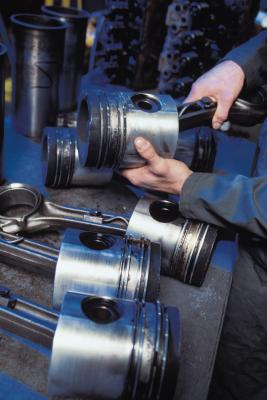
Eliminating the ignition source for the cylinder exhibiting rod knock does seem to make the defect disappear. However, a rod knock indicates a mechanical problem at the bottom end of the piston-connecting rod. The connecting rod is so-called because it connects the piston to the crankshaft. The small upper end of the rod loops around a pin that runs through the piston, while the larger bottom end loops around a journal of the engine crankshaft. A shim-like metal bearing in this loop prevents wear of the rod and crankshaft while maintaining the precise clearance needed for lubrication. Should this bearing become worn or damaged, the clearance becomes exaggerated well beyond any specified tolerances.
Combustion inside a cylinder takes place when the spark plug ignites the compressed air-fuel mixture. The piston is at, or near, the top of its stroke at that time, having compressed the mixture. The combustion forces the piston down, and the impact resulting from the excess clearance of the defective rod makes a deep knocking noise. Professional-grade engine analyzer machines are capable of shutting off the ignition spark in any engine cylinder. By "killing" cylinders one at a time, a technician can determine the source of the knocking noise. When combustion ceases in the suspect cylinder, no explosive force acts on the piston, and the defective rod is seemingly silenced. While this is a great means of diagnosing which cylinder is at fault, no permanent relief is achieved.
Circumventing the ignition of a cylinder creates new problems without addressing the actual defect. Raw fuel remains in the combustion chamber until the piston exhaust stroke pushes it into the exhaust system. Aside from the noxious emissions produced, some fuel can collect and possibly ignite in the exhaust system. Trace amounts of the raw fuel can also slip past the piston rings and pollute the engine oil. Removing the spark plug wire from any cylinder may have detrimental effects on ignition system components. The powerful voltage meant for the spark plug can scorch the distributor cap, ignition module or coil-pack assemblies. A disconnected plug wire left dangling in the engine compartment might ignite errant engine oil or gasoline.
The connecting rod remains defective even if audible symptoms can be quieted. The slightest amount of rod knock signifies damage of the rod bearing, at least. Small metal particles can slough off of the defective part and be carried throughout the engine by the oil. The polluted lubricant can cause destruction of the engine parts that normally benefit from its presence. Component damage could be widespread, should the knocking be ignored for any length of time. Given proper regard, the situation may not reach catastrophic levels. The old adage about opportunity knocking is actually appropriate in this instance.
Repairs for a quickly diagnosed rod knock may be as simple as replacing the defective bearing and flushing the crankcase before replenishing the oil and filter. However, this is rarely the case. Whatever factors lead to the destruction of this part typically affected others. At times, the crankshaft and connecting rod bearings can be replaced without a complete engine tear-down. Even these efforts can result in a mere patch-up that has no long-term benefit. The precise machining and repairs required to restore and re-size the crankshaft journals and rod ends often cost as much, or more, than a used or rebuilt engine for a particular vehicle.